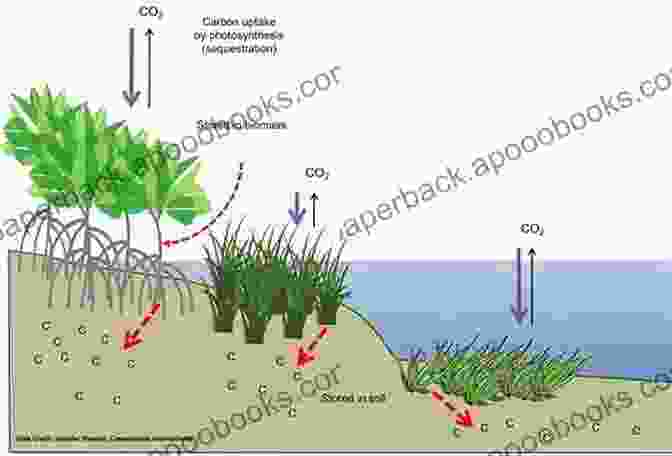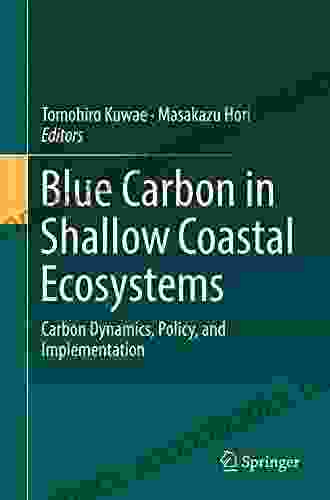Blue Carbon In Shallow Coastal Ecosystems: A Vital Resource for Climate Mitigation and Adaptation


4.2 out of 5
| Language | : | English |
| File size | : | 39842 KB |
| Text-to-Speech | : | Enabled |
| Screen Reader | : | Supported |
| Enhanced typesetting | : | Enabled |
| Word Wise | : | Enabled |
| Print length | : | 577 pages |
In the face of the urgent climate crisis, scientists and policymakers are exploring innovative ways to mitigate carbon emissions and adapt to its unavoidable impacts. One promising solution lies beneath our feet, in the submerged and intertidal zones of shallow coastal ecosystems. These unique habitats, dominated by mangroves, salt marshes, and seagrasses, play a crucial role in carbon sequestration, known as "blue carbon."
Mangroves: The Mighty Carbon-StoringTrees
Towering over the coastline, mangroves are salt-tolerant trees that thrive in muddy substrates and brackish waters. Their extensive root systems not only anchor them in soft sediment but also create a complex network of above- and below-ground biomass, accumulating vast amounts of carbon in their tissues and surrounding environment.
When mangrove leaves and other organic matter fall into the water, they are broken down by microorganisms and converted into carbon dioxide and methane. However, a significant portion of this organic matter becomes trapped in the sediment, where it is protected from decomposition by oxygen-depleted conditions. Over time, this accumulated organic matter forms carbon-rich peat and soil, acting as a long-term carbon sink.
Salt Marshes: Carbon Sequestration in Intertidal Zones
BFree Downloading estuaries and sheltered bays, salt marshes are dominated by salt-tolerant grasses and other vegetation that flourish in the fluctuating water levels and salinity. Like mangroves, salt marshes sequester carbon through the accumulation of organic matter in their sediments.
During high tides, salt marshes are submerged, and the vegetation traps suspended sediment and organic particles. As the tide recedes, this trapped material is exposed to air and oxygen, slowing down decomposition and allowing carbon to accumulate over time. Salt marshes also contribute to carbon storage through the production and burial of below-ground biomass, such as roots and rhizomes.
Seagrasses: Underwater Carbon Factories
Submerged in shallow waters, seagrasses form dense meadows that provide essential habitat for a multitude of marine life. These marine plants possess an efficient photosynthetic mechanism that allows them to capture and store carbon dioxide.
Through photosynthesis, seagrasses produce organic compounds, which are used for growth and energy production. A significant portion of these compounds is stored belowground in the form of rhizomes and roots. When seagrasses die, their organic matter is released into the sediment, where it undergoes anaerobic decomposition and contributes to carbon sequestration.
The Benefits of Blue Carbon Ecosystems
Beyond their remarkable capacity for carbon sequestration, blue carbon ecosystems provide a myriad of other benefits:
- Coastal protection: Mangroves, salt marshes, and seagrasses act as natural buffers against storms and erosion, reducing the impact of extreme weather events on coastal communities.
- Biodiversity hotspots: These ecosystems support a rich diversity of marine and terrestrial species, including birds, fish, shellfish, and mammals.
- Water filtration: Mangroves and salt marshes filter pollutants from water, improving water quality and protecting aquatic ecosystems.
- Climate change adaptation: By sequestering carbon dioxide, blue carbon ecosystems help mitigate climate change and reduce its impacts on coastal communities.
Conservation and Restoration: Investing in Our Future
Recognizing the immense value of blue carbon ecosystems, conservation and restoration efforts are crucial to protecting and enhancing their carbon sequestration capacity.
- Mangrove reforestation: Planting and restoring mangrove forests in degraded areas can significantly increase carbon storage while providing coastal protection benefits.
- Salt marsh conservation: Protecting existing salt marshes from development and pollution ensures the continued sequestration of carbon and other ecosystem services.
- Seagrass restoration: Replanting and rehabilitating seagrass meadows can enhance carbon sequestration, improve water quality, and support marine biodiversity.
By investing in the conservation and restoration of blue carbon ecosystems, we not only contribute to climate change mitigation and adaptation but also protect the biodiversity and ecosystem services that these vital habitats provide.
Blue carbon ecosystems are a natural treasure that offers a unique solution to the challenges of climate change. By understanding their role in carbon sequestration and the myriad benefits they provide, we can make informed decisions about their conservation and management. As we navigate the uncertain future of our planet, investing in the protection and restoration of blue carbon ecosystems is an investment in our own resilience and the well-being of generations to come.
4.2 out of 5
| Language | : | English |
| File size | : | 39842 KB |
| Text-to-Speech | : | Enabled |
| Screen Reader | : | Supported |
| Enhanced typesetting | : | Enabled |
| Word Wise | : | Enabled |
| Print length | : | 577 pages |
Do you want to contribute by writing guest posts on this blog?
Please contact us and send us a resume of previous articles that you have written.
 Book
Book Novel
Novel Page
Page Chapter
Chapter Text
Text Story
Story Genre
Genre Reader
Reader Library
Library Paperback
Paperback E-book
E-book Magazine
Magazine Newspaper
Newspaper Paragraph
Paragraph Sentence
Sentence Bookmark
Bookmark Shelf
Shelf Glossary
Glossary Bibliography
Bibliography Foreword
Foreword Preface
Preface Synopsis
Synopsis Annotation
Annotation Footnote
Footnote Manuscript
Manuscript Scroll
Scroll Codex
Codex Tome
Tome Bestseller
Bestseller Classics
Classics Library card
Library card Narrative
Narrative Biography
Biography Autobiography
Autobiography Memoir
Memoir Reference
Reference Encyclopedia
Encyclopedia Joanna Russ
Joanna Russ Jim Tankersley
Jim Tankersley Kristin Coley
Kristin Coley Jenny Holmes
Jenny Holmes Matteo Prefumo
Matteo Prefumo Reissue Edition Kindle Edition
Reissue Edition Kindle Edition Jess Walter
Jess Walter Jessie Bahrey
Jessie Bahrey Jerry Mander
Jerry Mander John Vincent
John Vincent Jean Robert Cadet
Jean Robert Cadet Jessie May
Jessie May Kit Sergeant
Kit Sergeant Jeffrey T Darbee
Jeffrey T Darbee Richard Paul Evans
Richard Paul Evans Johanna Wilson
Johanna Wilson John Corwin
John Corwin Jennifer Lenhardt
Jennifer Lenhardt Jeffry H Larson
Jeffry H Larson Suzu Takamine
Suzu Takamine
Light bulbAdvertise smarter! Our strategic ad space ensures maximum exposure. Reserve your spot today!

 Harvey HughesDragon Spear, Dragon Slippers: An Epic Fantasy Adventure That Will Ignite...
Harvey HughesDragon Spear, Dragon Slippers: An Epic Fantasy Adventure That Will Ignite...
 David PetersonUnveiling the Secrets of Lumbar Interbody Fusions: A Comprehensive Guide by...
David PetersonUnveiling the Secrets of Lumbar Interbody Fusions: A Comprehensive Guide by... George OrwellFollow ·7.8k
George OrwellFollow ·7.8k Ervin BellFollow ·5.6k
Ervin BellFollow ·5.6k Ricky BellFollow ·5.1k
Ricky BellFollow ·5.1k Chance FosterFollow ·11.1k
Chance FosterFollow ·11.1k Henry David ThoreauFollow ·5.4k
Henry David ThoreauFollow ·5.4k Eugene PowellFollow ·13.8k
Eugene PowellFollow ·13.8k George BellFollow ·2.6k
George BellFollow ·2.6k Phil FosterFollow ·15.5k
Phil FosterFollow ·15.5k

 Preston Simmons
Preston SimmonsEmbark on a Literary Odyssey with "Walking on Water": A...
Prepare to be swept...

 Ernesto Sabato
Ernesto SabatoUnlocking Policy Analysis: Dive into the Intricacies of...
: The Realm of Policy...

 Forrest Reed
Forrest ReedThe Road to Grace Walk: A Journey of Spiritual Growth and...
In the tapestry of life, we...

 Evan Simmons
Evan SimmonsTip Neill and the Democratic Century: A Political Odyssey...
The Rise of a Political Giant In the...

 Mark Mitchell
Mark MitchellUnwrap the Magic: A Review of Christmas Memory by Richard...
As the cold winter months draw near, and...

 Percy Bysshe Shelley
Percy Bysshe ShelleyBeyond the Veil: Delve into the Realm of Spirit with In...
Unveiling the Mysteries of the Unseen...
4.2 out of 5
| Language | : | English |
| File size | : | 39842 KB |
| Text-to-Speech | : | Enabled |
| Screen Reader | : | Supported |
| Enhanced typesetting | : | Enabled |
| Word Wise | : | Enabled |
| Print length | : | 577 pages |








